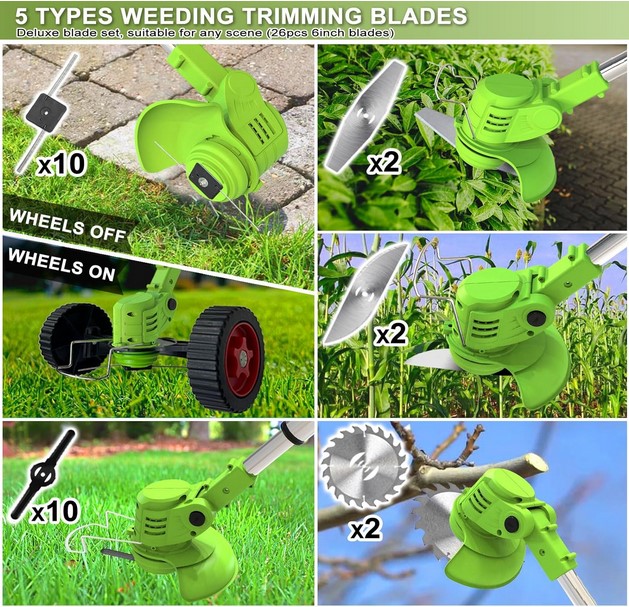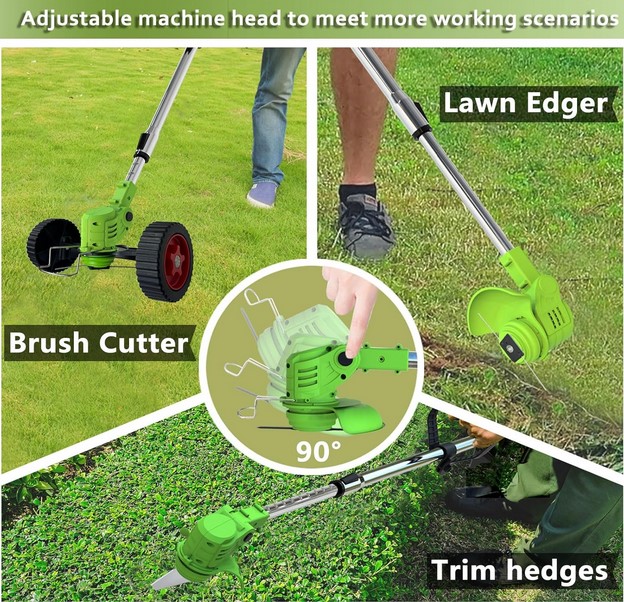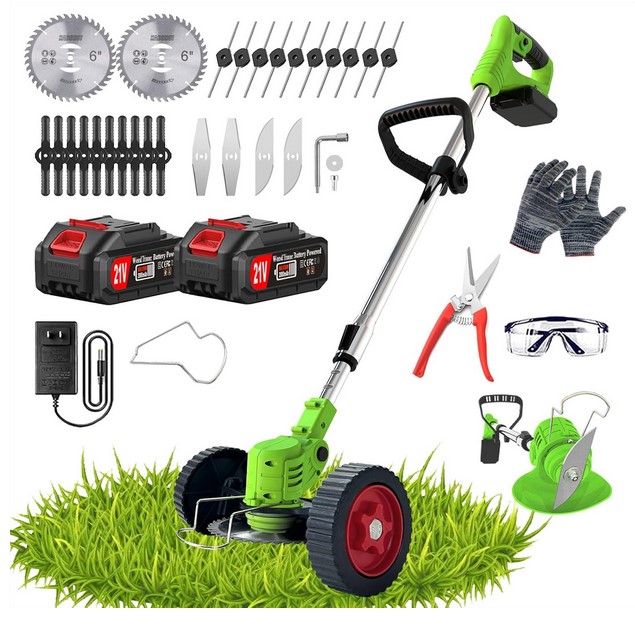An edger for landscaping is a gardening tool designed to create crisp, clean lines between different elements of your landscaping, such as lawns, flower beds, sidewalks, and driveways. It is an essential tool for achieving a well-manicured and polished look in your outdoor living spaces.
The primary purpose of an edger is to create a distinct separation between grass and other landscaping features, preventing grass from encroaching onto unwanted areas and maintaining a neat, defined appearance. Edgers can also be used to trench along borders, allowing for the installation of edging materials like bricks, stones, or plastic edging.
There are three main types of edgers for landscaping:
- Manual Edgers: These are handheld tools that require manual effort to operate. They typically feature a half-moon shaped blade or a flat, vertical blade that you push or pull along the desired edge. Manual edgers are best suited for smaller yards or occasional edging tasks.
- Gas-Powered Edgers: These edgers are powered by gasoline engines and offer more power and efficiency for larger yards or frequent edging needs. Gas-powered edgers can be walk-behind models or handheld trimmers with an edging attachment. They are more expensive but significantly reduce the physical effort required.
- Electric Edgers: Electric edgers are powered by electricity, either through a corded connection or rechargeable batteries. They offer the convenience of no emissions and less noise than gas-powered models. Electric edgers are typically lighter and easier to maneuver, making them a popular choice for homeowners with moderate edging needs.
Table of Contents
Importance of Edger for Landscaping
Edging is a crucial aspect of landscaping that offers several benefits. First and foremost, it enhances the overall curb appeal of your property by creating clean, defined lines between different landscaping elements, such as lawns, flower beds, and walkways. This visual distinction adds a polished and well-maintained appearance to your outdoor spaces.
Additionally, edging serves a practical purpose by defining borders and preventing grass and weeds from encroaching into unwanted areas. By creating a physical barrier, edging helps maintain the integrity of your landscaping design and prevents the need for constant trimming or weeding along the edges.
Moreover, edging can improve the efficiency of lawn maintenance tasks. With clearly defined borders, mowing and trimming become more precise and easier, saving time and effort. This also contributes to a neater overall appearance, as grass clippings and debris are less likely to spill onto adjacent areas.
Furthermore, edging can enhance the aesthetic appeal of your landscape by allowing you to incorporate decorative elements, such as bricks, pavers, or decorative edging materials. These additions can complement the overall design and add visual interest to your outdoor spaces.

Manual Edgers
Manual edgers are a simple and cost-effective option for maintaining clean, crisp edges around your landscape beds, walkways, and driveways. These tools rely solely on human power, making them an eco-friendly choice that generates no emissions or noise pollution. They are particularly well-suited for smaller yards or areas where gas-powered equipment is not permitted or desired.
One of the primary advantages of manual edgers is their affordability. They typically cost between $10 and $50, making them an accessible option for homeowners on a budget. Additionally, they are relatively lightweight and easy to maneuver, making them a practical choice for those with limited mobility or strength.
However, manual edging can be a labor-intensive task, especially in larger yards or areas with extensive edging needs. The physical effort required can be strenuous, and the process can be time-consuming compared to powered alternatives.
There are two main types of manual edgers: half-moon and flat. Half-moon edgers feature a curved blade that allows for a smooth, rounded edge, while flat edgers have a straight blade that creates a sharper, more defined edge. The choice between the two often comes down to personal preference and the desired aesthetic.
Manual edgers are best suited for smaller yards or areas with minimal edging needs. They are also a great option for touch-ups or spot edging between larger edging sessions. Additionally, they can be useful in tight spaces or areas where larger powered equipment may not fit or maneuver easily.
Gas-Powered Edgers
Gas-powered edgers are popular choices for landscaping professionals and homeowners with larger properties. These edgers are known for their powerful engines, which allow them to tackle even the toughest overgrown areas and dense soil conditions with ease.
Pros:
- Power and Efficiency: Gas-powered edgers are incredibly powerful, making them highly efficient at cutting through thick grass, roots, and compacted soil. They can cover large areas in a relatively short amount of time, saving you valuable time and effort.
- Mobility: Many gas-powered edgers are designed with wheels or are walk-behind models, which enhances their maneuverability and makes it easier to navigate around obstacles and curves in your landscape.
Cons:
- Noise: Gas engines tend to be quite noisy, which can be a nuisance, especially in residential areas or when working early in the morning or late at night.
- Emissions: Gas-powered edgers produce emissions, which can contribute to air pollution and have a negative impact on the environment.
- Fuel Costs: The cost of gasoline can add up over time, especially if you have a large property or use the edger frequently.
Types of Gas-Powered Edgers:
- Walk-Behind Edgers: These edgers are designed to be pushed and guided by the user, similar to a lawn mower. They are typically more powerful and suitable for larger properties or commercial use.
- Wheeled Edgers: Wheeled edgers have one or more wheels, which provide better maneuverability and stability. They are often preferred for residential use or smaller properties.
Maintenance Tips:
- Regularly change the oil and air filters to ensure optimal performance and extend the life of the engine.
- Clean the edger after each use to prevent buildup of debris, which can cause clogs or damage.
- Sharpen or replace the edger blade when it becomes dull or damaged for a clean, efficient cut.
- Store the edger in a dry, protected area when not in use, and follow proper winterization procedures if storing for an extended period.
Gas-powered edgers offer exceptional power and efficiency, making them a popular choice for landscaping professionals and homeowners with larger properties. However, their noise, emissions, and fuel costs should be considered when making a purchase decision.
Electric Edgers
Electric edgers offer a quieter and more eco-friendly alternative to gas-powered models. They are available in both corded and cordless varieties, each with its own advantages and drawbacks.
Corded Electric Edgers
Corded electric edgers are tethered to a power source, providing a consistent flow of electricity. This eliminates the need for batteries or gasoline, making them a cost-effective option in the long run. However, their mobility is limited by the length of the power cord, which can be inconvenient when working on larger properties.
Cordless Electric Edgers
Cordless electric edgers run on rechargeable batteries, offering greater mobility and freedom of movement. They are ideal for smaller yards or areas where access to power outlets is limited. However, their runtime is restricted by battery capacity, and you may need to have spare batteries on hand for larger jobs.
Pros of Electric Edgers
- Quieter Operation: Electric edgers produce significantly less noise than their gas-powered counterparts, making them a more neighbor-friendly choice, especially in residential areas.
- Eco-Friendly: With no emissions, electric edgers are an environmentally conscious option for landscaping tasks.
- Low Maintenance: Electric edgers require less maintenance than gas-powered models, as there are no spark plugs, air filters, or fuel systems to maintain.
Cons of Electric Edgers
- Limited Power: While suitable for most residential applications, electric edgers may struggle with tough or overgrown vegetation, particularly when compared to gas-powered models.
- Battery Life (for cordless models): Cordless electric edgers have a limited runtime, which can be a challenge for larger properties or extended use.
- Corded Mobility (for corded models): Corded electric edgers are restricted by the length of the power cord, limiting their range and maneuverability.
When choosing an electric edger, consider the size of your property, the type of vegetation you’ll be working with, and your power source availability. Corded models offer consistent power but limited mobility, while cordless options provide greater freedom of movement at the expense of runtime. Both types are generally quieter, more eco-friendly, and require less maintenance than gas-powered edgers, making them an attractive choice for many homeowners and landscapers.
Choosing the Right Edger
Selecting the right edger for your landscaping needs is crucial to ensure efficient and effective edging. Several factors should be considered when choosing an edger, including the size of the area to be edged, the terrain, your budget, and power requirements.
Area Size and Terrain: The size of your lawn or garden and the terrain will play a significant role in determining the type of edger you need. For smaller areas with flat terrain, a manual or electric edger may suffice. However, for larger areas or uneven terrain, a gas-powered edger with more power and maneuverability may be necessary.
Budget: Edgers come in a range of prices, from affordable manual options to more expensive gas-powered models. Determine your budget and prioritize the features that are most important to you, such as power, durability, and ease of use.
Power Needs: Manual edgers are suitable for light edging tasks and smaller areas, while electric edgers offer more power and convenience. Gas-powered edgers are the most powerful option, making them ideal for larger areas, tough terrain, and heavy-duty edging tasks.
When it comes to popular brands and models, some of the top choices include:
- ECHO: Known for their reliable and powerful gas-powered edgers, ECHO offers models like the ECHO PE-265 and ECHO PE-266 that are designed for professional landscaping applications.
- Husqvarna: Husqvarna’s edgers, such as the Husqvarna 967623405 and Husqvarna 967646901, are popular for their durability and ease of use, making them suitable for both residential and commercial use.
- McLane: McLane offers a range of edgers, including the McLane 101-5.5GT-7 and McLane 101-5.5GT-9, which are known for their precision and maneuverability, making them ideal for intricate edging tasks.
- Greenworks: For those seeking eco-friendly and quiet electric edgers, Greenworks offers models like the Greenworks 27032 and Greenworks 27037 that provide ample power without the noise and emissions of gas-powered options.
When choosing the right edger, consider your specific needs, budget, and the features that will make the edging process more efficient and enjoyable for you.

Edging Techniques and Best Practices
Proper edging depth is crucial for maintaining a well-defined edge between your lawn and garden beds or hardscapes. Generally, it’s recommended to edge to a depth of 2-4 inches, depending on the type of grass and soil conditions. Edging too shallow may result in grass quickly growing back over the edge, while edging too deep can damage grass roots and make it difficult to maintain a clean line.
The frequency of edging depends on the growth rate of your grass and the desired level of neatness. Most homeowners edge their lawns every 1-2 weeks during the peak growing season, and less frequently during cooler months. Consistent edging is key to maintaining a well-groomed appearance.
Edge styles can vary depending on personal preference and the overall landscape design. Straight edges create a formal, clean look, while curved edges can add a softer, more natural feel. When edging alongside hardscapes like walkways or driveways, it’s important to follow the contours and lines of the hardscape for a cohesive look.
For curved edges, use a half-moon edger or a flat-head shovel to create smooth, flowing lines. For straight edges, a standard edging tool or a flat spade can help achieve crisp, clean lines. When edging alongside hardscapes, take care not to damage the surfaces with your edging tool, and consider using a specialized edger designed for this purpose.
Edging Tools and Accessories
Edging tools and accessories can greatly enhance the efficiency and effectiveness of your edging tasks. While an edger is the primary tool, several complementary tools and gear can make the process easier, safer, and more precise.
Edger Blades: The blade is the heart of an edger, responsible for cutting through soil and vegetation along the lawn’s edge. Edger blades come in various materials, such as steel, aluminum, or plastic, and different blade shapes and designs cater to specific edging needs. Choosing the right blade can improve cutting performance, reduce vibration, and extend the blade’s lifespan.
Edging Shovels: Edging shovels, also known as edging spades or edging irons, are specialized tools designed for creating clean, crisp edges along garden beds, walkways, and lawn borders. These tools feature a flat, narrow blade and a footplate that allows you to apply pressure with your foot, making it easier to cut through tough soil and roots.
Edging Restraints: Edging restraints, or lawn edging, are flexible or rigid materials used to create a physical barrier between the lawn and garden beds, walkways, or other landscape features. These restraints help maintain a clear separation and prevent grass or plants from encroaching into unwanted areas. Common edging restraints include plastic, metal, brick, or stone edging.
Safety Gear: Edging can involve flying debris, loud noise, and potential hazards, making safety gear essential. Goggles or safety glasses protect your eyes from dirt, rocks, or vegetation that may be kicked up during edging. Gloves provide a secure grip and protect your hands from blisters, cuts, and abrasions. Ear protection, such as earmuffs or earplugs, is recommended when using gas-powered or electric edgers to prevent hearing damage from the engine noise.
Investing in high-quality edging tools and accessories can significantly improve the appearance of your landscape, reduce physical strain, and ensure a safer and more efficient edging experience.
Edging and Lawn Care
Edging is an essential component of a well-maintained landscape, but it’s not the only factor that contributes to a polished and attractive yard. To achieve a truly pristine appearance, edging should be complemented by proper lawn care practices, including mowing, fertilizing, and aerating.
Regular mowing is crucial for maintaining a healthy and lush lawn. Proper mowing techniques, such as cutting at the recommended height for your grass type and avoiding removing more than one-third of the blade height, can promote dense and vigorous growth. Additionally, alternating mowing patterns can help prevent soil compaction and create a visually appealing striped effect.
Fertilizing your lawn is another essential step in maintaining its overall health and appearance. A well-fertilized lawn will have a deeper green color, increased density, and improved resistance to stress and disease. It’s important to choose the right fertilizer and apply it at the appropriate times of the year, following the manufacturer’s instructions carefully.
Aerating your lawn is a process that involves creating small holes in the soil to allow air, water, and nutrients to penetrate more easily. This practice is particularly beneficial for lawns with compacted soil, as it helps to improve drainage and root growth. Aerating can be done manually with a hand tool or with a mechanical aerator, and it’s typically recommended to aerate once or twice a year, depending on your climate and soil conditions.
By combining edging with proper mowing, fertilizing, and aerating practices, you can achieve a truly polished and well-manicured landscape. The crisp, clean lines created by edging will be complemented by a lush, vibrant lawn, creating a visually stunning and cohesive outdoor space. Remember, consistency is key, so be sure to follow a regular maintenance schedule to keep your lawn and landscape looking their best.
Hiring Professional Edging Services
Maintaining crisp, clean edges around your landscape features can be a time-consuming and physically demanding task. For many homeowners and businesses, hiring professional edging services can be a convenient and cost-effective solution. Here are some factors to consider when outsourcing your edging needs:
Factors to Consider:
- Size of your property and complexity of the landscape design
- Frequency of edging required (weekly, monthly, seasonally)
- Your physical abilities and time constraints
- Access to specialized edging equipment and tools
Costs:
The cost of professional edging services can vary depending on the provider, location, and scope of work. Many companies offer package deals or annual contracts, which can be more cost-effective than one-time services. Expect to pay hourly rates ranging from $30 to $100 or more, depending on the size of your property and the level of expertise required.
Finding Reputable Providers:
- Ask for recommendations from neighbors, friends, or local garden centers
- Check online reviews and ratings for local edging services
- Verify that the company is licensed, insured, and has experienced staff
- Request quotes from multiple providers and compare services and pricing
Advantages of Outsourcing:
- Professional results with crisp, clean edges
- Time-saving convenience
- Access to specialized equipment and expertise
- Consistent maintenance without the physical strain
- Potential cost savings compared to purchasing and maintaining equipment
When hiring professional edging services, be sure to communicate your expectations clearly, provide access to the necessary areas, and establish a schedule that works for both parties. With the right provider, you can enjoy a well-manicured landscape without the hassle of edging yourself.
Edging for Different Landscapes
Edging plays a crucial role in enhancing the overall aesthetic appeal and functionality of various landscape settings. Whether you have a residential garden, a winding pathway, a driveway, or a commercial property, proper edging techniques can make a significant difference in defining boundaries, creating clean lines, and maintaining a well-groomed appearance.
Gardens
In garden settings, edging serves as a barrier between planting beds and lawns or walkways. It helps prevent grass and weeds from encroaching into the garden area, making maintenance easier. Edging can be achieved using various materials, such as bricks, stones, plastic edging, or even metal strips. For gardens with curved or intricate designs, flexible edging materials like plastic or metal are recommended for a seamless and visually appealing finish.
Pathways
Edging along pathways not only enhances their visual appeal but also helps prevent soil erosion and keeps the pathway well-defined. Stone or brick edging can add a rustic charm to garden paths, while metal or plastic edging provides a more modern and clean look. When edging pathways, consider the overall landscape design and choose materials that complement the surrounding elements.
Driveways
Edging along driveways serves both functional and aesthetic purposes. It helps prevent grass and weeds from encroaching onto the driveway surface, reducing maintenance efforts. Additionally, edging can enhance the overall curb appeal of your property. Popular options for driveway edging include concrete curbing, brick, or stone borders. For a more cost-effective solution, plastic or metal edging can also be used.
Commercial Properties
In commercial settings, such as office buildings, parks, or public spaces, edging plays a crucial role in maintaining a well-manicured and professional appearance. Concrete curbing or metal edging are popular choices for their durability and low maintenance requirements. Proper edging helps define boundaries, separates planting areas from walkways or parking lots, and contributes to a polished and organized landscape.
Tips for Unique Landscapes
For landscapes with unique features or challenging terrain, creativity and adaptability are key when it comes to edging. In sloped areas, terraced edging or retaining walls can help prevent soil erosion and create distinct planting zones. In rocky or uneven landscapes, flexible edging materials like plastic or metal can be molded to follow the contours of the terrain. Additionally, incorporating decorative elements like boulders, logs, or recycled materials can add character and individuality to your edging design.
Remember, edging is not only about creating boundaries but also about enhancing the overall aesthetic appeal and functionality of your landscape. By carefully considering the specific needs and design elements of your outdoor space, you can choose the most suitable edging techniques and materials to create a cohesive and visually striking landscape.
Edging and Landscape Design
Edging plays a crucial role in landscape design, not only defining boundaries and creating a neat appearance but also enhancing the overall aesthetic appeal of outdoor spaces. Incorporating edging into the overall landscape plan can elevate the design and create a cohesive, polished look.
One of the primary functions of edging in landscape design is to create clean lines and define distinct areas within the landscape. By using edging materials such as brick, stone, or metal, you can separate different elements like garden beds, lawns, and walkways, creating a visually appealing contrast and a sense of order.
Edging can also be used to highlight specific features or focal points within the landscape. For instance, you can use a decorative edging material to frame a garden bed or a water feature, drawing the eye to these areas and enhancing their visual impact.
When planning your landscape design, consider the style and theme you want to achieve. The choice of edging material can complement the overall aesthetic, whether it’s a modern, minimalist look with clean lines and sleek edging, or a more rustic, natural feel with rough-hewn stones or reclaimed materials.
Curved edging can add a softer, more organic feel to the landscape, while straight lines and geometric shapes can create a more formal and structured appearance. By combining different edging materials and patterns, you can create visual interest and depth within the landscape.
Additionally, edging can be used to create raised garden beds or terraced areas, adding vertical interest and allowing for better soil drainage and root development. This can be particularly beneficial in sloped landscapes or areas with poor soil conditions.
When incorporating edging into your landscape design, consider the overall flow and movement within the space. Edging can be used to guide the eye and create visual pathways, leading visitors through the landscape in a cohesive and intentional manner.
Ultimately, edging is a versatile tool in landscape design that can enhance the aesthetic appeal, create structure, and tie together various elements within the outdoor space. By thoughtfully incorporating edging into your overall landscape plan, you can create a beautiful, functional, and visually stunning outdoor environment.
Maintaining and Repairing Edging
Proper maintenance and timely repairs are crucial for ensuring the longevity and effectiveness of your edging. Over time, even the most well-constructed edging can show signs of wear and tear, potentially compromising the neat appearance of your landscape. By staying vigilant and addressing issues promptly, you can prevent further deterioration and maintain a polished, manicured look.
Signs of Wear:
- Cracked or chipped edging material
- Loose or dislodged edging sections
- Soil erosion or washout around the edging
- Overgrown grass or weeds encroaching on the edging
- Discoloration or fading of the edging material
Re-edging:
When your existing edging has become severely damaged or outdated, it may be time to consider re-edging. This process involves removing the old edging material and installing a new one. Re-edging allows you to refresh the appearance of your landscape and address any underlying issues that may have contributed to the deterioration of the previous edging.
Fixing Damaged Edges:
If the damage to your edging is localized, you may be able to repair it without the need for a complete replacement. For minor cracks or chips, you can use a suitable sealant or filler to patch the affected areas. In cases of dislodged sections, you can carefully reset the edging and secure it in place with additional stakes or anchors.
Preventing Future Issues:
To minimize the need for frequent repairs and extend the lifespan of your edging, consider implementing the following preventive measures:
- Use high-quality edging materials suitable for your climate and soil conditions.
- Install edging properly, following manufacturer’s instructions and best practices.
- Maintain a consistent watering schedule to prevent soil erosion or shifting.
- Regularly remove debris, weeds, and overgrown vegetation around the edging.
- Avoid direct impact or stress on the edging during lawn maintenance or landscaping activities.
- Consider applying a protective sealant or coating to enhance durability and resistance to weathering.
By staying proactive and addressing any issues promptly, you can ensure that your edging remains a functional and visually appealing element of your landscape for years to come.
Edging Safety and Ergonomics
Proper body mechanics and ergonomics are crucial when using edgers to prevent strain, fatigue, and potential injuries. Edging involves repetitive motions and awkward postures, which can put stress on your back, shoulders, and wrists if not done correctly.
One of the most important aspects of safe edging is maintaining a proper stance and body positioning. Avoid excessive bending or twisting at the waist, which can lead to lower back pain. Instead, bend at the knees and keep your back straight, engaging your core muscles for support. Adjust the edger’s height to minimize stooping or reaching too far.
To reduce strain on your arms and shoulders, use the edger’s weight as leverage and let the machine do the work. Avoid bearing down with excessive force, which can cause muscle fatigue and strain. Take frequent breaks to rest and stretch, especially if you feel discomfort or fatigue setting in.
Protective gear is essential for edging safety. Wear sturdy, closed-toe shoes with good traction to prevent slips and falls. Protective eyewear is also recommended to shield your eyes from flying debris. Long pants and gloves can protect your skin from cuts and abrasions.
Common injuries associated with edging include back pain, shoulder strain, wrist tendonitis, and hand or foot injuries from contact with the edger’s blade or debris. Be mindful of your surroundings and watch for potential tripping hazards, such as uneven ground or obstacles in your path.
By following proper body mechanics, using ergonomic techniques, and wearing appropriate protective gear, you can minimize the risk of injuries and strain while edging, ensuring a safe and efficient landscaping experience.
Edging Innovations and Future Trends
The world of landscaping and edging is constantly evolving, with new tools, materials, and technologies emerging to make the process more efficient, eco-friendly, and precise. One of the most exciting innovations in edging is the development of robotic edgers. These automated machines use advanced sensors and navigation systems to accurately detect and follow the edges of lawns, flower beds, and other landscaping features, providing a clean, crisp edging without the need for human intervention.
Another trend in edging is the use of eco-friendly materials. Traditional edging materials like plastic and metal can be harmful to the environment and contribute to waste. As a result, many landscapers and homeowners are turning to sustainable options such as recycled rubber, composite materials made from recycled plastics and wood fibers, or even natural materials like stone or bricks. These eco-friendly edging solutions not only reduce environmental impact but also often provide a more visually appealing and long-lasting solution.
In addition to new materials, there is also a growing interest in eco-friendly edging tools and techniques. For example, some manufacturers are developing electric edgers that are powered by rechargeable batteries or solar panels, reducing the need for gasoline and minimizing emissions. Other innovations include edgers with advanced cutting systems that produce minimal waste and require less frequent maintenance.
Overall, the future of edging in landscaping is focused on sustainability, efficiency, and precision. As technology continues to advance and environmental concerns become more pressing, we can expect to see even more innovative solutions that make edging easier, more eco-friendly, and better integrated into overall landscape design and maintenance.



